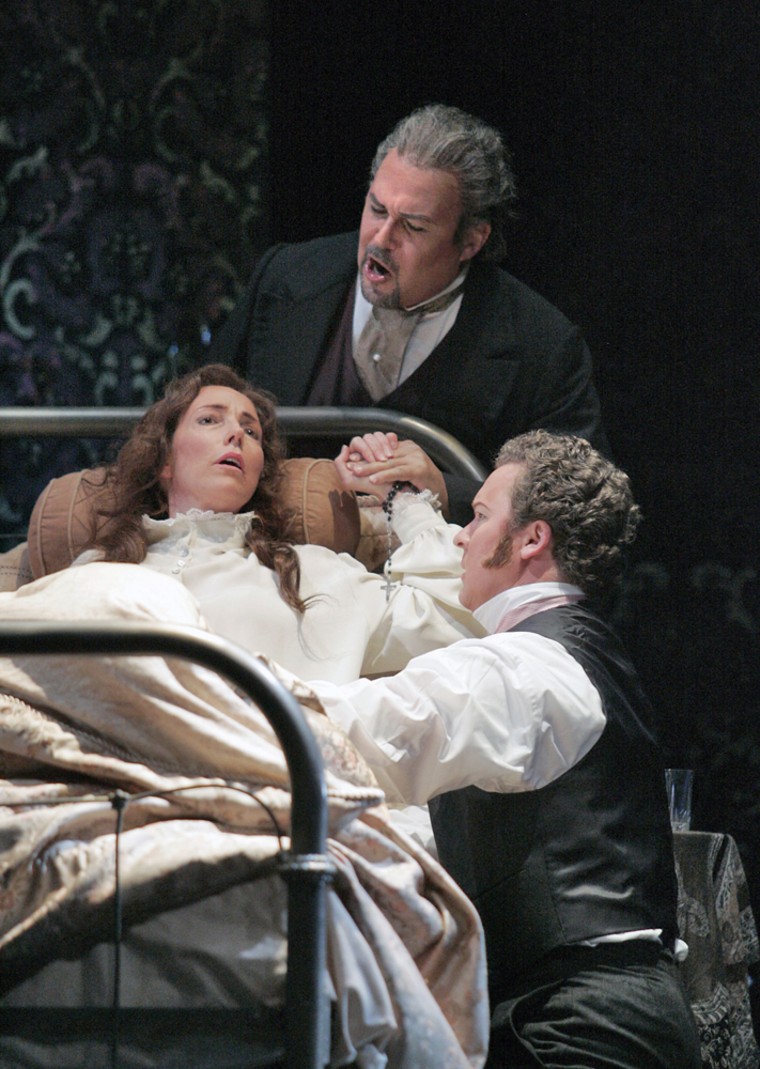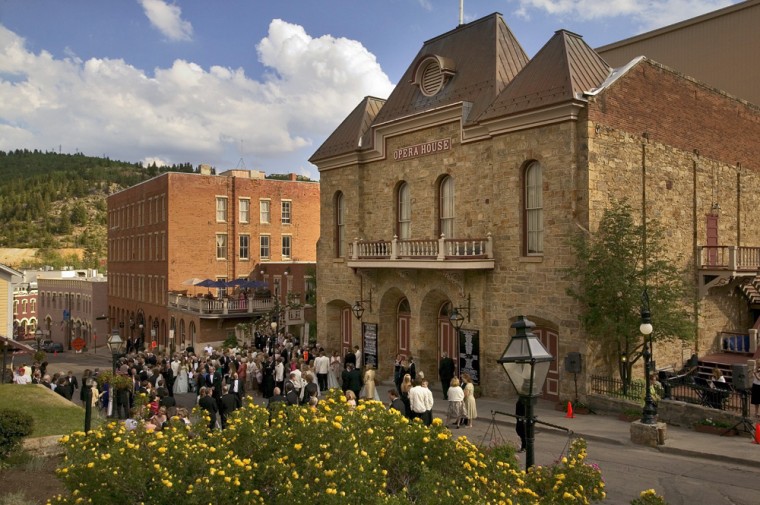At almost 8,500 feet in the Rockies, it can take a few breaths to walk up Central City's steep granite hills lined with Victorian homes, souvenir shops — and an opera house that has served 19th-century gold miners as well as modern-day visitors.
For almost a century and a half, Central City and other Colorado mountain towns have been alive with the sounds of opera. Partly because of its opera house, Central City, up Clear Creek Canyon some 40 miles west of Denver, is a national historic district and such a marvel of local history one can almost hear the Cornish miners singing.
But Central City Opera is not just a relic of the past. It is a vibrant, popular arts venue, with nearly 24,000 tickets sold in 2007 and a record $1.25 million in sales. The opera hopes to bring in as much or more business this summer, with performances of Benjamin Britten's "The Rape of Lucretia," a new production of Leonard Bernstein's "West Side Story," and American composer Carlisle Floyd's "Susannah," the story of a woman accused of immorality and shunned by a rural Tennessee community.
Still, the opera has its roots in the rough and tumble mining days of the 19th century. European immigrants to towns like Central City brought their musical traditions with them. A town's mark of civilization included having a sheriff, a courthouse and an opera house. Theaters wouldn't do because they often also housed brothels or put on "leg shows."
"They hankered for some kind of civilized lifestyle that would ameliorate their loneliness and the drudgery of the work they were doing," said Charles Ralph, a Colorado opera historian. "Having entertainment, especially coupled with attractive people, mainly female, was exactly what they wanted."
In Central City, opera supporters in the town of 3,000 raised $12,000 in 1878 to hire a Denver architect to design the building and $23,000 to build it over Eureka Creek. The interior's trompe l'oeil murals were created by John C. Massman of San Francisco. Fortunately, several months before it opened, gas became available, so it did not have to rely on hundreds of kerosene lamps.
In all, about 150 opera houses were built in Colorado between 1860 and 1920. Thirteen are still in operation, including several in once-struggling mountain mining towns such as Aspen and Crested Butte. Three operas will be staged this summer as part of the Aspen Music Festival: "La Cenerentola" (July 8, 10 and 13), "Hansel and Gretel" (July 24, 27 and 28) and "Cendrillon" (Aug. 12, 14 and 16). The Crested Butte Music Festival is staging "Falstaff" July 24 in Crested Butte, July 26 in Gunnison and July 27 in Crested Butte. Opera Fort Collins offers "La Boheme" Aug. 22 and 24.
In Denver, the Tabor House Opera opened in 1881. A gilded curtain painted by artist Robert Hopkins depicted a "moody neoclassical city in ruins" across the 72-foot-wide stage, flanked by balconies trimmed in carved cherry wood, according to Colorado historian Tom Noel.
The building, used for the 1908 Democratic National Convention, was renovated in 2005 and became the Ellie Caukins Opera House, boasting state-of-the-art sound and lyrics on seatbacks. The theater is now home to Opera Colorado, which offers four operas a year. Performances of its summer opera, "Nixon in China," were scheduled to run through June 15, and "Madama Butterfly" will be staged in November.
Central City's musical traditions predate its opera house. During the Civil War, troupes held shows on makeshift stages for the gold-seekers who swarmed what was billed as "the richest square mile on Earth" and "The Little Kingdom of Gilpin County."

It wasn't always genteel. In 1861, a theater manager shot and killed the leader of a minstrel group from a balcony. The shooting was ruled to be justified, though the details remain vague.
Central City's mineral riches and mountain beauty attracted top-name stars. A seat for a grand opera cost $5 in the 1870s, a pretty penny in those days.
"Whether you want to dig down into them, or climb up them, or ski down them, or just look at them, these mountains have always been a magnet," said John Moriarty, the Central City Opera's artistic director emeritus.
The Central City Opera House celebrates its 130th birthday this year, and the roster of stars who have performed there over the decades is impressive. Sarah Bernhardt and Edwin Booth appeared, as did John Philip Sousa and his band and the original Christy Minstrels. Pirated versions of the popular operettas of Gilbert & Sullivan were frequently performed. In 1937, Evalyn Walsh McLean wore the Hope Diamond on opening night of the play "A Doll's House."
Beverly Sills, Paul Plishka, Jerome Hines and dozens more have been featured. Actors and actresses who appeared at Central City include Walter Huston, Ruth Gordon, Sam Jaffe, Mae West, Helen Hayes, Myrna Loy and Michael Redgrave. In 1932, Lillian Gish starred in "Camille," which was broadcast nationwide on NBC. A guard carrying two pistols sat in the front row because Gish wore a borrowed necklace worth $100,000.
But Central City Opera hasn't been content to simply perform the classics. It's presented six world premieres, including a 2007 staging of a new Chinese opera, "Poet Li Bai," the story of the legendary poet. Variety hailed the production as "a hopeful sign for the future of global opera."
Soprano Catherine Malfitano made her directorial debut in 2005 at Central City and returned in 2007 to direct "The Saint of Bleecker Street."
Offseason, the Central City Opera Ensemble Artists travel the state with its Education and Community Programs. Under John Moriarty's guidance, the company's Bonfils-Stanton Foundation Artists Training Program (celebrating 30 years in 2008) has become a national model for training young singers — fulfilling the aspirations of Anne Evans, a promoter of the opera's reopening, who declared in 1932: "Someday Central City will become a living shrine to living theatre and the early pioneers of Colorado."
